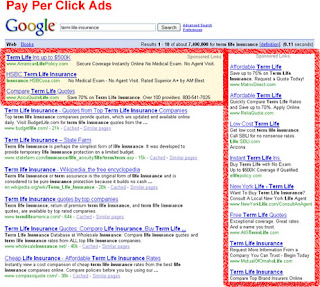Pay Per Click (PPC) (also called Cost per click) is an Internet advertising model used to direct traffic to websites, where advertisers pay the publisher (typically a website owner) when the ad is clicked. With search engines, advertisers typically bid on keyword phrases relevant to their target market. Content sites commonly charge a fixed price per click rather than use a bidding system. PPC "display" advertisements are shown on web sites or search engine results with related content that have agreed to show ads. This approach differs from the "pay per impression" methods used in television and newspaper advertising.
DefinitionShort for pay per click, PPC is an Internet marketing formula used to price online advertisements. In PPC programs the online advertisers will pay Internet Publishers the agreed upon PPC rate when an ad is clicked on, regardless if a sale is made or not.
With pay per click in search engine advertising, the advertiser would typically bid on a keyword so the PPC rate changes. On single website -- or network of content websites -- the site publisher would usually set a fixed pay per click rate. Also called cost-per-click (CPC).
In contrast to the generalized portal, which seeks to drive a high volume of traffic to one site, PPC implements the so-called affiliate model, that provides purchase opportunities wherever people may be surfing. It does this by offering financial incentives (in the form of a percentage of revenue) to affiliated partner sites. The affiliates provide purchase-point click-through to the merchant. It is a pay-for-performance model: If an affiliate does not generate sales, it represents no cost to the merchant. Variations include banner exchange, pay-per-click, and revenue sharing programs.
Websites that utilize PPC ads will display an advertisement when a keyword query matches an advertiser's keyword list, or when a content site displays relevant content. Such advertisements are called sponsored links or sponsored ads, and appear adjacent to or above organic results on search engine results pages, or anywhere a web developer chooses on a content site.
Among PPC providers, Google AdWords, Yahoo! Search Marketing, and Microsoft adCenter are the three largest network operators, and all three operate under a bid-based model.
The PPC advertising model is open to abuse through click fraud, although Google and others have implemented automated systems to guard against abusive clicks by competitors or corrupt web developers.
Determining Cost Per Click
There are two primary models for determining cost per click: flat-rate and bid-based. In both cases the advertiser must consider the potential value of a click from a given source. This value is based on the type of individual the advertiser is expecting to receive as a visitor to his or her website, and what the advertiser can gain from that visit, usually revenue, both in the short term as well as in the long term. As with other forms of advertising targeting is key, and factors that often play into PPC campaigns include the target's interest (often defined by a search term they have entered into a search engine, or the content of a page that they are browsing), intent (e.g., to purchase or not), location (for geo targeting), and the day and time that they are browsing.
Flat Rate PPC
In the flat-rate model, the advertiser and publisher agree upon a fixed amount that will be paid for each click. In many cases the publisher has a rate card that lists the Cost Per Click (CPC) within different areas of their website or network. These various amounts are often related to the content on pages, with content that generally attracts more valuable visitors having a higher CPC than content that attracts less valuable visitors. However, in many cases advertisers can negotiate lower rates, especially when committing to a long-term or high-value contract.
The flat-rate model is particularly common to comparison shopping engines, which typically publish rate cards. However, these rates are sometimes minimal, and advertisers can pay more for greater visibility. These sites are usually neatly compartmentalized into product or service categories, allowing a high degree of targeting by advertisers. In many cases, the entire core content of these sites is paid ads.
Bid Based PPC
In the bid-based model, the advertiser signs a contract that allows them to compete against other advertisers in a private auction hosted by a publisher or, more commonly, an advertising network. Each advertiser informs the host of the maximum amount that he or she is willing to pay for a given ad spot (often based on a keyword), usually using online tools to do so. The auction plays out in an automated fashion every time a visitor triggers the ad spot.
When the ad spot is part of a search engine results page (SERP), the automated auction takes place whenever a search for the keyword that is being bid upon occurs. All bids for the keyword that target the searcher's geo-location, the day and time of the search, etc. are then compared and the winner determined. In situations where there are multiple ad spots, a common occurrence on SERPs, there can be multiple winners whose positions on the page are influenced by the amount each has bid. The ad with the highest bid generally shows up first, though additional factors such as ad quality and relevance can sometimes come into play (see Quality Score).
In addition to ad spots on SERPs, the major advertising networks allow for contextual ads to be placed on the properties of 3rd-parties with whom they have partnered. These publishers sign up to host ads on behalf of the network. In return, they receive a portion of the ad revenue that the network generates, which can be anywhere from 50% to over 80% of the gross revenue paid by advertisers. These properties are often referred to as a content network and the ads on them as contextual ads because the ad spots are associated with keywords based on the context of the page on which they are found. In general, ads on content networks have a much lower click-through rate (CTR) and conversion rate (CR) than ads found on SERPs and consequently are less highly valued. Content network properties can include websites, newsletters, and e-mails.
Advertisers pay for each click they receive, with the actual amount paid based on the amount bid. It is common practice amongst auction hosts to charge a winning bidder just slightly more (e.g. one penny) than the next highest bidder or the actual amount bid, whichever is lower.This avoids situations where bidders are constantly adjusting their bids by very small amounts to see if they can still win the auction while paying just a little bit less per click.
To maximize success and achieve scale, automated bid management systems can be deployed. These systems can be used directly by the advertiser, though they are more commonly used by advertising agencies that offer PPC bid management as a service. These tools generally allow for bid management at scale, with thousands or even millions of PPC bids controlled by a highly automated system. The system generally sets each bid based on the goal that has been set for it, such as maximize profit, maximize traffic at breakeven, and so forth. The system is usually tied into the advertiser's website and fed the results of each click, which then allows it to set bids. The effectiveness of these systems is directly related to the quality and quantity of the performance data that they have to work with - low-traffic ads can lead to a scarcity of data problem that renders many bid management tools useless at worst, or inefficient at best.
History
In February 1998 Jeffrey Brewer of Goto.com, a 25-employee startup company (later Overture, now part of Yahoo!), presented a pay per click search engine proof-of-concept to the TED conference in California. This presentation and the events that followed created the PPC advertising system. Credit for the concept of the PPC model is generally given to Idealab and Goto.com founder Bill Gross.
Google started search engine advertising in December 1999. It was not until October 2000 that the AdWords system was introduced, allowing advertisers to create text ads for placement on the Google search engine. However, PPC was only introduced in 2002; until then, advertisements were charged at cost-per-thousand impressions. Overture has filed a patent infringement lawsuit against Google, saying the rival search service overstepped its bounds with its ad-placement tools.
Although GoTo.com started PPC in 1998, Yahoo! did not start syndicating GoTo.com (later Overture) advertisers until November 2001.Prior to this, Yahoo's primary source of SERPS advertising included contextual IAB advertising units (mainly 468x60 display ads). When the syndication contract with Yahoo! was up for renewal in July 2003, Yahoo! announced intent to acquire Overture for $1.63 billion.



.jpg)



.jpg)







